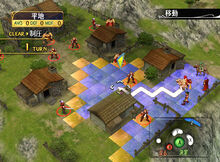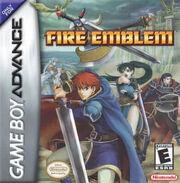Template:RelevantLinks
- If you're looking for the GBA game that came out in the United States, please go to Fire Emblem: Blazing Sword instead.

From Fire Emblem: Path of Radiance for the Gamecube.
The Fire Emblem series are turn-based strategy RPGs that are very story & text heavy. They are known for their rich stories, characters, and deep & difficult yet simple gameplay. The Shining Force games were Sega's attempt at duplicating the succes of Fire Emblem in Japan. It is one of the first and most influential series of Strategy RPGs.
The name "Fire Emblem" refers to an Emblem in the first game (Fire Emblem: Dragon of Darkness and Sword of Light) that the main character, Marth, combined with his divine sword, the Falchion.
Despite being extremely popular in Japan, has only come to American shores in 2003. The first Fire Emblem game to be released outside of Japan was Fire Emblem: The Blazing Sword and was released as, simply, "Fire Emblem". The games, so far, are all in a fantasy/medieval setting. The games have been developed by the minds at Nintendo's Intelligent Systems, creators of Advance Wars. This explains the extreme similarities in gameplay.
Fire Emblem received a boost in popularity state-side when two main FE characters, Marth and Roy, were included as secret characters in Super Smash Bros. Melee. Paper Mario: The Thousand-Year Door has a reference to Fire Emblem.
You can easily search & link the Fire Emblem titles through abbreviations such as FE1, FE2, FE3, etc. depending on what number they are in the series.
Distinguishing Features
There are certain distinguishing features that seperate the Fire Emblem games from other Strategy RPGs like Final Fantasy Tactics or Ogre Battle.
- Difficulty. Fire Emblem games are usually hard. While veterans of the series may find the recent GBA offerings to be the easiest yet, first time players can expect frustration.
- Permanent Death. Unlike other strategy RPGs, death in the game, when past the tutorial, is permanent. This takes away most "sacrificial" strategy typical of games in this genre. Most players will prefer to keep everyone alive just in case. While this may be frustrating, this mechanic tends to create an interesting conflict for the player when they've lost a soldier but are close to winning the map: Should the player move on and accept this characters ultimate sacrifice? Or is this character too important, and worth restarting the entire map over again?
- Characters, not Units. The characters are usually a big varied cast, with backstories and personalities that you can unlock through support conversations. This, along with permanent death, tends to make the player more attached to the men and women he or she controls.
- Spiffy Animation. The games, at least in their 2D iterations, tend to have well done attack animations.
Games

Fire Emblem 7
- Fire Emblem: Dragon of Darkness and Sword of Light (Famicom/NES)
- Fire Emblem Gaiden (Famicom/NES)
- Fire Emblem: Mystery of the Emblem (Super Famicom/SNES)
- Fire Emblem: Genealogy of the Holy War (Super Famicom/SNES)
- Fire Emblem: Thracia 776 (Super Famicom/SNES)
- Fire Emblem: Sword of Seals (Game Boy Advance)
- Fire Emblem: The Blazing Sword (Game Boy Advance)
- Fire Emblem: The Sacred Stones (Game Boy Advance)
- Fire Emblem: Path of Radiance (GameCube)
- Fire Emblem: Radiant Dawn (Wii)
- Fire Emblem DS (Nintendo DS)
History-making characters
Several Fire Emblem characters have made history in the Fire Emblem series.
- Marth - From Fire Emblem: Dragon of Darkness and Sword of Light and Fire Emblem: Mystery of the Emblem, is the first Lord, and, also, the only Lord who kept his position during two games. He also appeared as a secret playable character in Super Smash Bros. Melee.
- Celica - From Fire Emblem Gaiden, is the first female main character.
- Siglud - From Fire Emblem: Genealogy of Holy War, is the first in the Lord class to have exceptional stats and the first Lord to be mounted on a horse.
- Ira - From Fire Emblem: Genealogy of Holy War, is the first popular female swordfighter, and the first female character to start a class that is also held by male characters. She is one of the most popular Fire Emblem characters. She is the originator of the Myrmidon and Swordmaster classes, which is what many call their favorite class.
- Leaf - From Fire Emblem: Genealogy of Holy War and Thracia 776, is the first in the Lord class to have a hair color that is not blue.
- Roy - From Fire Emblem: Sword of Seals, is featured as an unlockable character, similar to Marth but with more power and less speed, in Super Smash Bros. Melee. He appeared in Super Smash Bros. Melee before appearing in his own Fire Emblem game. Additionally, he makes a cameo appearance as a child in Fire Emblem: The Blazing Sword
- Lyndis - From Fire Emblem: The Blazing Sword, is the first female character to be in the Lord class. A female Lord is sometimes called a Lady.
- Hector - From Fire Emblem: The Blazing Sword, is the first in the Lord class to wield an axe.
- Eirika - From Fire Emblem: The Sacred Stones, is the first female character to be the game's main Lord all the way through game ending.
- Ephraim - From Fire Emblem: The Sacred Stones, is the first in the Lord class to wield a lance on foot.
- Ike - From Fire Emblem: Path of Radiance, possibly the first male lead character that is not in the Lord class (he's a Ranger).
Mythological references
Fire Emblem has extensive mythological references. For example, Fire Emblem: Genealogy of Holy War has extensive references to Norse, Celtic, Greek, and Polynesian mythology. Sigurd of Chalphy, Edin (Etain) of Jungby, Isaac Kingdom's Balmunk sword, Mistoleen (Misteltein), Mjolnir (Mjlnir), Chalphy's Tailfing sword, and Thracia Kingdom's Gungnir spear are references to Norse mythology. Cuan (Cchulainn/Cian), Ethlin (Ethniu), and Fin (Fionn) of Lenster, and Mideel (Midir) of Jungby (Yngvi), from Fire Emblem: Seisen no Keifu, Felgus from Fire Emblem: Thracia 776, Lugh from Fire Emblem: Sword of Seals, and Erk from Fire Emblem: The Blazing Sword are references to Celtic mythology. Rackesis (Lachesis) is a reference to Greek mythology. Paora from Fire Emblem: Monshou no Nazo, and Ira and Mana from Fire Emblem: Genealogy of Holy War are references to Polynesian mythology. Norse mythology and Celtic mythology are prominent contributors to names in the Fire Emblem series.
